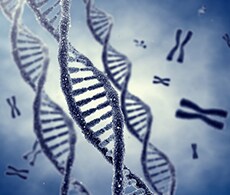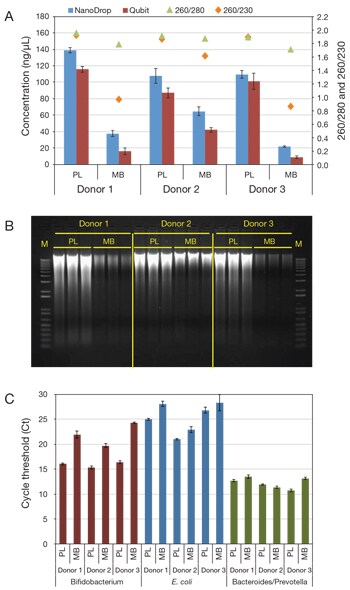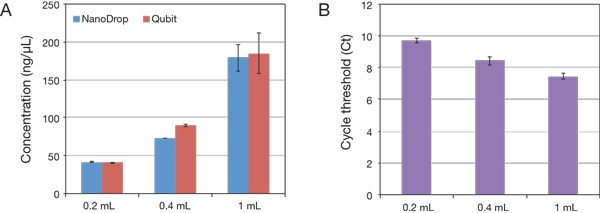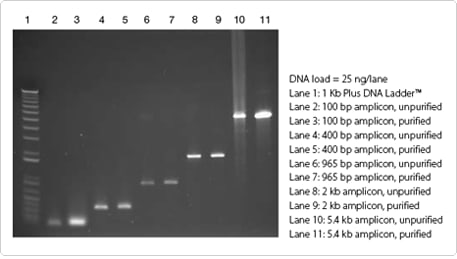Search
DNA 片段分离和 PCR 产物纯化

Kits for DNA gel extraction, cell-free DNA isolation, PCR clean-up, and microbiome DNA extraction
Whether you prefer organic reagents, filter columns, or magnetic beads, our products for Isolation of DNA fragments are designed for sensitive, scalable extraction and are compatible with a range of downstream applications.
Looking to isolate genomic DNA? Check out genomic DNA extraction by sample type
DNA extraction from cell-free samples
Biological fluid samples, such as plasma, serum, and urine, contain cell-free DNA (cfDNA). cfDNA is used in pathogen detection, and cfDNA targets are being used as biomarkers in oncology research. Isolation of cfDNA is challenging because of its low abundance in typical samples. In pathogen detection, virus particles are also typically in low abundance and therefore are challenging to capture. Thus, large volumes of biological fluids (which can be difficult to handle) are required to obtain sufficient amounts of cfDNA for analysis. We have developed scalable products capable of handling these large volumes while efficiently recovering cfDNA from a broad range of sample types in several format options.
Which DNA extraction kit for plasma, serum, and urine samples is right for you?
| Order now | Order now | Order now | |
| Fast isolation of viral nucleic acid | Easy-to-use, high-sensitivity | Automated format, capable of processing large volumes of plasma | |
|---|---|---|---|
| PureLink Viral RNA/DNA Mini Kit | PureLink Pro 96 Viral RNA/DNA Purification Kit | MagMAX Cell-Free DNA Isolation Kit | |
| Sample input | 500 µL | 200 µL | 0.5–10 mL |
| Compatible samples | Plasma, serum, cerebrospinal fluid | Plasma, serum, cerebrospinal fluid | Plasma, serum, urine |
| Isolation method | Silica membrane | Filter plate | Magnetic beads |
| High-throughput compatible | No | Yes | Yes |
| Compatible applications | Cloning, qPCR, sequencing, genotyping | Cloning, qPCR, sequencing, genotyping | Cloning, qPCR, sequencing, genotyping |
| Prep time | 15 min | 35 min | 24 samples in <1 hr |
| Prep size | 50 preps | 4 x 96 preps | 50 preps |
PureLink Microbiome DNA Purification Kit
The Invitrogen PureLink Microbiome DNA Purification Kit enables rapid isolation of high-quality microbial and host DNA from a wide variety of sample types, including challenging samples such as stool and soil. The kit uses proven PureLink spin column technology for robust yields of purified DNA from bacteria or fungi, ready for downstream applications such as PCR and sequencing. The highly efficient triple-lysis approach, fast removal of inhibitors, and versatility of this DNA extraction procedure make it the ultimate kit for microbiome research projects as well as programs aimed at rapid detection of pathogenic bacteria in various samples.
The PureLink Microbiome DNA Purification Kit offers:
- Efficient lysis of all microorganisms (including durable species with thick and complex cell walls) by a combination of heat, chemical, and mechanical disruption with specialized beads
- Elimination of inhibitory compounds by precipitation using a novel cleanup buffer
- Streamlined protocols for a variety of biological samples
- Recovery of highly pure DNA compatible with PCR, sequencing, and many other types of downstream analysis
One kit to isolate microbial and host DNA from a diversity of sample types
The PureLink Microbiome DNA Purification Kit is designed to eliminate the need to order “specialized” kits because it has been optimized for use with a wide range of biological samples. This versatile kit enables microbial (and host, where applicable) DNA purification from the following samples:
|
|
Video: How to purify microbial and host DNA from stool samples
Learn how to isolate microbial DNA that accurately reflects the diverse microbes in the community sampled. This video will provide an outline of stool microbial DNA isolation, plus some tips and tricks. In addition to stool, the PureLink Microbiome DNA Purification Kit can be used to isolate DNA from urine, saliva, swabs, transport media, microbial culture, and soil.
View all PureLink Microbiome DNA Purification Kit product user guides
Video: Bringing bacteria out of hiding: Understanding the microbiome.
Dr. Watts, the co-director of the Genomics Shared Service at the University of Arizona Cancer Center, focuses on understanding the human microbiome and its role in disease onset and progression. In particular, they are employing 16S RNA sequencing to help correctly identify all of the bacteria present in individuals with diabetic foot ulcers.
Supporting experimental data


Figure 2. Purification of bacterial DNA from culture media.E. coli DNA was isolated from 0.2, 0.4, and 1 mL culture samples (in triplicate) with the PureLink Microbiome DNA Purification Kit.
(A) Concentrations of DNA as measured by a Thermo Scientific NanoDrop spectrophotometer (blue bars) and Invitrogen Qubit fluorometer (red bars) are shown. For all preparations DNA was highly pure: A260/A280 = 1.9, A260/A230 = 2.1–2.3.
(B) qPCR analysis with an E. coli–specific TaqMan assay. Threshold cycles (Ct) are displayed for isolations performed with three sample input volumes.
User guides
DNA 复杂混合物的 PCR 产物纯化
PCR 产物纯化是一种常规但非常耗时的实验室程序。现在,您可以使用一种更简单、更快速、更安全的方法并获得更好的结果。使用简单快速的 PCR 产物纯化方法进行 DNA 纯化,可有效去除短引物、未掺入的 dNTP、酶、短链扩增失败的 PCR 产物和 PCR 反应中的盐。
分离出的 DNA 可用于测序、PCR、转录、标测、克隆和标记。我们提供一系列 Invitrogen PCR 产物纯化试剂盒以及全方位支持服务来帮助您获得高产量、高纯度的 DNA。
哪一种 PCR 产物纯化试剂盒适合您?
| 立即订购 | 立即订购 | 立即订购 | 立即订购 | |
| 快速高效地去除副产物 | 浓缩低产量 PCR 产物的理想选择 | 简单、可靠、快速的方法,96孔规格 | 快速、可扩展,磁珠形式 | |
|---|---|---|---|---|
| PureLink PCR 纯化试剂盒 | PureLink PCR 微量纯化试剂盒 | PureLink 96 PCR 纯化试剂盒 | ChargeSwitch PCR 产物纯化试剂盒 | |
| 形式 | 离心/真空柱 | 离心/真空柱 | 96孔板(真空/离心机) | 磁珠 |
| 方案时间 | 15 分钟 | 15 分钟 | 15 分钟 | 5 分钟 |
| 样本体积 | 50–100 µL | 50–100 µL | 50–100 µL | 25–50 µL |
| 质粒 DNA产量 | 高达40 µg | 高达20 µg | 高达20 µg | 高达30 µg |
| DNA 片段大小 | 100 bp–15 kb | 100 bp–15 kb | 100 bp–15 kb | 90 bp–40 kb |
| 结合能力 | 高达40 µg | 高达40 µg | 高达40 µg | 每 mg 磁珠颗粒约 25 µg |
| 下游应用 | 测序、测序(下一代)、核酸标记、PCR、克隆 | 测序、核酸标记、PCR、克隆 | 测序、克隆 | 测序、测序(下一代)、微阵列分析、PCR、克隆 |
| 高通量兼容性 | 否 | 否 | 是 | 是 |
| 包装规格 | 50制备 250次制备 | 50制备 250次制备 | 4块微孔板 | 100制备 960次制备 |
| 货号 | K310001 K310002 | K310050 K310250 | K3100-96A | CS12000 CS12000-10 |
是否既支持 PCR 纯化又支持凝胶提取?
如果是这样的话,请考虑我们的 Invitrogen PureLink 套装试剂盒,这样您就能使用单个试剂盒执行任一过程。
进一步了解 Invitrogen PureLink 快速凝胶提取和 PCR 纯化套装试剂盒
Quick and easy gel extraction of DNA
The PureLink Quick Gel Extraction Kit is designed to purify DNA fragments from agarose gels in less than 30 minutes. The simple procedure uses a unique silica-membrane spin column to capture and purify DNA fragments from 40 bp to 10 kb, without the need for pH adjustment. Isolated DNA is free of proteins, dye, and agarose and is ready to use in a variety of applications, including DNA sequencing, PCR, in vitro transcription, restriction mapping, cloning, and labeling (Figure 1).

Green benefits of the PureLink Quick Gel Extraction Kit 
- Less hazardous
- Less use of nonrenewable resources
- Less energy to produce
- Decreased fuel consumption and greenhouse gas emissions for transport
- Less waste disposal
PureLink Combo Kit
Isolating DNA from complex PCR mixtures and recovering bands from agarose gels? Try our combo kit
The PureLink Quick Gel Extraction and PCR Purification Combo Kit offers the ability to perform both gel extraction and PCR purification in a single kit.
Learn more about the PureLink Quick Gel Extraction and PCR Purification Combo Kit ›
Technical Resources
|
Sequence-Specific RNA/DNA Purification
Invitrogen streptavidin-coupled Dynabeads are a robust and versatile tool that can be used to capture specific RNA or DNA sequences and then pull them directly out of solution. These monosized superparamagnetic Dynabeads provide an efficient and solid-phase alternative to nitrocellulose and provide you with an unmatched level of product quality and data consistency. Excellent near–liquid phase reaction kinetics allow for extremely fast protocols. The inherent ease of magnetic handling means that downstream manipulations and buffer changes are as simple as concentrating the bead-bound target at the tube-wall with a magnet and then discarding the supernatant. These beads are compatible with an extremely broad range of sample types including most bodily fluids, crude lysates of plant, animal and microbial origin as well as purified total RNA or DNA. Since these Dynabeads will only interact with specifically targeted RNA or DNA molecules, upstream purification of total RNA or DNA is almost always an unnecessary step.

The direct capture procedure involves the immobilization of double-stranded PCR products onto the beads. These are easily converted to single-stranded bead-bound templates which are then used to capture specific RNA or DNA molecules directly from solution.
An alternative indirect capture approach will offer faster reaction kinetics in some cases. This indirect capture procedure allows the target sequence to be captured prior to being immobilized the magnetic beads. First, a biotinylated capture-sequence (single-stranded DNA) is incubated with the sample and allowed to hybridize to the targeted RNA or DNA molecules in solution. Streptavidin-coated Dynabeads are then added to the mixture and the hybridized sequences are immobilized onto the Dynabeads via the streptavidin-biotin bond.
The 1 µm Dynabeads MyOne Streptavidin C1 present a very high surface area per mg of beads, enabling high enrichment of low abundance RNA or DNA. When the goal is to capture nucleic acid from more viscous samples such as cerebrospinal fluid, the larger 2.8 µm sized Dynabeads M-270 Streptavidin are recommended. These Dynabeads (MyOne Streptavidin C1 and M-270 Streptavidin) are optimally designed to have slightly negatively charged surfaces which ensure negligible non-specific binding of non-target nucleic acid sequences.
Examples of applications include; isolation of RNA/DNA infectious agent (1,2,3,4), subtractive hybridization (5,6,7), cDNA selection and enrichment, detection and isolation of mutated sequences (8,9,10), isolation of cell specific transcripts and mRNA differential display.
Learn more about Nucleic Acid Capture Assays ›
- Meng Q. et al. (2001) Automated multiplex assay system for simultaneous detection of hepatitis B virus DNA, hepatitis C virus RNA and human immunodeficiency virus type 1 RNA. J.Clin.Microbiol. 39(8):2937-2945.
- Stevens SJC. et al. (1999) Monitoring of Epstein-Barr virus DNA load in peripheral blood by quantitative competitive PCR. J.Clin. Microbiol. 37:2852-2857.
- Mangiapan G. et al. (1996) Sequence capture-PCR improves detection of mycobacterial DNA in clinical specimens. J. Clin. Microbiol. 34(5):1209-1215.
- Shuber AP. et.al. (2002) Accurate, noninvasive detection of Helicobacter pylori DNA from stool samples: potential usefulness for monitoring treatment. J. Clin. Microbiol. 40(1):262-264.
- Hansen-Hagge TE. et.al. (2001) Identification of sample-specific sequences in mammalian cDNA and genomic DNA by the novel ligation-mediated subtraction (LIMES). Nucl. Acids Res. 29(4):e20.
- Pradel N. et.al. (2002) Genomic subtraction to identify and characterize sequences of Shiga toxin-producing Escherichia coli O91:H21. Appl. Env. Microbiol. 68(5):2316-2325.
- Laveder P. et.al. (2002) A two-step strategy for constructing specifically self-subtracted cDNA libraries. Nucleic Acids Res. 30(9):e38.
- Lindblad-Toh K.et.al. (2000) Large-scale discovery and genotyping of single-nucleotide polymorphisms in the mouse. Nature Genetics. 24:381-386.
- Miyashiro I. et.al. (2001) Molecular strategy for detecting metastatic cancers with use of multiple tumor-specific MAGE-A genes. Clin.Chem. 47(3):505-512.
- Dong SM. et.al. (2001) Detection of colorectal cancer in stool with the use of multiple genetic targets. J Natl. Cancer Inst. 93(11):858-865.
DNA extraction from cell-free samples
Biological fluid samples, such as plasma, serum, and urine, contain cell-free DNA (cfDNA). cfDNA is used in pathogen detection, and cfDNA targets are being used as biomarkers in oncology research. Isolation of cfDNA is challenging because of its low abundance in typical samples. In pathogen detection, virus particles are also typically in low abundance and therefore are challenging to capture. Thus, large volumes of biological fluids (which can be difficult to handle) are required to obtain sufficient amounts of cfDNA for analysis. We have developed scalable products capable of handling these large volumes while efficiently recovering cfDNA from a broad range of sample types in several format options.
Which DNA extraction kit for plasma, serum, and urine samples is right for you?
| Order now | Order now | Order now | |
| Fast isolation of viral nucleic acid | Easy-to-use, high-sensitivity | Automated format, capable of processing large volumes of plasma | |
|---|---|---|---|
| PureLink Viral RNA/DNA Mini Kit | PureLink Pro 96 Viral RNA/DNA Purification Kit | MagMAX Cell-Free DNA Isolation Kit | |
| Sample input | 500 µL | 200 µL | 0.5–10 mL |
| Compatible samples | Plasma, serum, cerebrospinal fluid | Plasma, serum, cerebrospinal fluid | Plasma, serum, urine |
| Isolation method | Silica membrane | Filter plate | Magnetic beads |
| High-throughput compatible | No | Yes | Yes |
| Compatible applications | Cloning, qPCR, sequencing, genotyping | Cloning, qPCR, sequencing, genotyping | Cloning, qPCR, sequencing, genotyping |
| Prep time | 15 min | 35 min | 24 samples in <1 hr |
| Prep size | 50 preps | 4 x 96 preps | 50 preps |
PureLink Microbiome DNA Purification Kit
The Invitrogen PureLink Microbiome DNA Purification Kit enables rapid isolation of high-quality microbial and host DNA from a wide variety of sample types, including challenging samples such as stool and soil. The kit uses proven PureLink spin column technology for robust yields of purified DNA from bacteria or fungi, ready for downstream applications such as PCR and sequencing. The highly efficient triple-lysis approach, fast removal of inhibitors, and versatility of this DNA extraction procedure make it the ultimate kit for microbiome research projects as well as programs aimed at rapid detection of pathogenic bacteria in various samples.
The PureLink Microbiome DNA Purification Kit offers:
- Efficient lysis of all microorganisms (including durable species with thick and complex cell walls) by a combination of heat, chemical, and mechanical disruption with specialized beads
- Elimination of inhibitory compounds by precipitation using a novel cleanup buffer
- Streamlined protocols for a variety of biological samples
- Recovery of highly pure DNA compatible with PCR, sequencing, and many other types of downstream analysis
One kit to isolate microbial and host DNA from a diversity of sample types
The PureLink Microbiome DNA Purification Kit is designed to eliminate the need to order “specialized” kits because it has been optimized for use with a wide range of biological samples. This versatile kit enables microbial (and host, where applicable) DNA purification from the following samples:
|
|
Video: How to purify microbial and host DNA from stool samples
Learn how to isolate microbial DNA that accurately reflects the diverse microbes in the community sampled. This video will provide an outline of stool microbial DNA isolation, plus some tips and tricks. In addition to stool, the PureLink Microbiome DNA Purification Kit can be used to isolate DNA from urine, saliva, swabs, transport media, microbial culture, and soil.
View all PureLink Microbiome DNA Purification Kit product user guides
Video: Bringing bacteria out of hiding: Understanding the microbiome.
Dr. Watts, the co-director of the Genomics Shared Service at the University of Arizona Cancer Center, focuses on understanding the human microbiome and its role in disease onset and progression. In particular, they are employing 16S RNA sequencing to help correctly identify all of the bacteria present in individuals with diabetic foot ulcers.
Supporting experimental data


Figure 2. Purification of bacterial DNA from culture media.E. coli DNA was isolated from 0.2, 0.4, and 1 mL culture samples (in triplicate) with the PureLink Microbiome DNA Purification Kit.
(A) Concentrations of DNA as measured by a Thermo Scientific NanoDrop spectrophotometer (blue bars) and Invitrogen Qubit fluorometer (red bars) are shown. For all preparations DNA was highly pure: A260/A280 = 1.9, A260/A230 = 2.1–2.3.
(B) qPCR analysis with an E. coli–specific TaqMan assay. Threshold cycles (Ct) are displayed for isolations performed with three sample input volumes.
User guides
DNA 复杂混合物的 PCR 产物纯化
PCR 产物纯化是一种常规但非常耗时的实验室程序。现在,您可以使用一种更简单、更快速、更安全的方法并获得更好的结果。使用简单快速的 PCR 产物纯化方法进行 DNA 纯化,可有效去除短引物、未掺入的 dNTP、酶、短链扩增失败的 PCR 产物和 PCR 反应中的盐。
分离出的 DNA 可用于测序、PCR、转录、标测、克隆和标记。我们提供一系列 Invitrogen PCR 产物纯化试剂盒以及全方位支持服务来帮助您获得高产量、高纯度的 DNA。
哪一种 PCR 产物纯化试剂盒适合您?
| 立即订购 | 立即订购 | 立即订购 | 立即订购 | |
| 快速高效地去除副产物 | 浓缩低产量 PCR 产物的理想选择 | 简单、可靠、快速的方法,96孔规格 | 快速、可扩展,磁珠形式 | |
|---|---|---|---|---|
| PureLink PCR 纯化试剂盒 | PureLink PCR 微量纯化试剂盒 | PureLink 96 PCR 纯化试剂盒 | ChargeSwitch PCR 产物纯化试剂盒 | |
| 形式 | 离心/真空柱 | 离心/真空柱 | 96孔板(真空/离心机) | 磁珠 |
| 方案时间 | 15 分钟 | 15 分钟 | 15 分钟 | 5 分钟 |
| 样本体积 | 50–100 µL | 50–100 µL | 50–100 µL | 25–50 µL |
| 质粒 DNA产量 | 高达40 µg | 高达20 µg | 高达20 µg | 高达30 µg |
| DNA 片段大小 | 100 bp–15 kb | 100 bp–15 kb | 100 bp–15 kb | 90 bp–40 kb |
| 结合能力 | 高达40 µg | 高达40 µg | 高达40 µg | 每 mg 磁珠颗粒约 25 µg |
| 下游应用 | 测序、测序(下一代)、核酸标记、PCR、克隆 | 测序、核酸标记、PCR、克隆 | 测序、克隆 | 测序、测序(下一代)、微阵列分析、PCR、克隆 |
| 高通量兼容性 | 否 | 否 | 是 | 是 |
| 包装规格 | 50制备 250次制备 | 50制备 250次制备 | 4块微孔板 | 100制备 960次制备 |
| 货号 | K310001 K310002 | K310050 K310250 | K3100-96A | CS12000 CS12000-10 |
是否既支持 PCR 纯化又支持凝胶提取?
如果是这样的话,请考虑我们的 Invitrogen PureLink 套装试剂盒,这样您就能使用单个试剂盒执行任一过程。
进一步了解 Invitrogen PureLink 快速凝胶提取和 PCR 纯化套装试剂盒
Quick and easy gel extraction of DNA
The PureLink Quick Gel Extraction Kit is designed to purify DNA fragments from agarose gels in less than 30 minutes. The simple procedure uses a unique silica-membrane spin column to capture and purify DNA fragments from 40 bp to 10 kb, without the need for pH adjustment. Isolated DNA is free of proteins, dye, and agarose and is ready to use in a variety of applications, including DNA sequencing, PCR, in vitro transcription, restriction mapping, cloning, and labeling (Figure 1).

Green benefits of the PureLink Quick Gel Extraction Kit 
- Less hazardous
- Less use of nonrenewable resources
- Less energy to produce
- Decreased fuel consumption and greenhouse gas emissions for transport
- Less waste disposal
PureLink Combo Kit
Isolating DNA from complex PCR mixtures and recovering bands from agarose gels? Try our combo kit
The PureLink Quick Gel Extraction and PCR Purification Combo Kit offers the ability to perform both gel extraction and PCR purification in a single kit.
Learn more about the PureLink Quick Gel Extraction and PCR Purification Combo Kit ›
Technical Resources
|
Sequence-Specific RNA/DNA Purification
Invitrogen streptavidin-coupled Dynabeads are a robust and versatile tool that can be used to capture specific RNA or DNA sequences and then pull them directly out of solution. These monosized superparamagnetic Dynabeads provide an efficient and solid-phase alternative to nitrocellulose and provide you with an unmatched level of product quality and data consistency. Excellent near–liquid phase reaction kinetics allow for extremely fast protocols. The inherent ease of magnetic handling means that downstream manipulations and buffer changes are as simple as concentrating the bead-bound target at the tube-wall with a magnet and then discarding the supernatant. These beads are compatible with an extremely broad range of sample types including most bodily fluids, crude lysates of plant, animal and microbial origin as well as purified total RNA or DNA. Since these Dynabeads will only interact with specifically targeted RNA or DNA molecules, upstream purification of total RNA or DNA is almost always an unnecessary step.

The direct capture procedure involves the immobilization of double-stranded PCR products onto the beads. These are easily converted to single-stranded bead-bound templates which are then used to capture specific RNA or DNA molecules directly from solution.
An alternative indirect capture approach will offer faster reaction kinetics in some cases. This indirect capture procedure allows the target sequence to be captured prior to being immobilized the magnetic beads. First, a biotinylated capture-sequence (single-stranded DNA) is incubated with the sample and allowed to hybridize to the targeted RNA or DNA molecules in solution. Streptavidin-coated Dynabeads are then added to the mixture and the hybridized sequences are immobilized onto the Dynabeads via the streptavidin-biotin bond.
The 1 µm Dynabeads MyOne Streptavidin C1 present a very high surface area per mg of beads, enabling high enrichment of low abundance RNA or DNA. When the goal is to capture nucleic acid from more viscous samples such as cerebrospinal fluid, the larger 2.8 µm sized Dynabeads M-270 Streptavidin are recommended. These Dynabeads (MyOne Streptavidin C1 and M-270 Streptavidin) are optimally designed to have slightly negatively charged surfaces which ensure negligible non-specific binding of non-target nucleic acid sequences.
Examples of applications include; isolation of RNA/DNA infectious agent (1,2,3,4), subtractive hybridization (5,6,7), cDNA selection and enrichment, detection and isolation of mutated sequences (8,9,10), isolation of cell specific transcripts and mRNA differential display.
Learn more about Nucleic Acid Capture Assays ›
- Meng Q. et al. (2001) Automated multiplex assay system for simultaneous detection of hepatitis B virus DNA, hepatitis C virus RNA and human immunodeficiency virus type 1 RNA. J.Clin.Microbiol. 39(8):2937-2945.
- Stevens SJC. et al. (1999) Monitoring of Epstein-Barr virus DNA load in peripheral blood by quantitative competitive PCR. J.Clin. Microbiol. 37:2852-2857.
- Mangiapan G. et al. (1996) Sequence capture-PCR improves detection of mycobacterial DNA in clinical specimens. J. Clin. Microbiol. 34(5):1209-1215.
- Shuber AP. et.al. (2002) Accurate, noninvasive detection of Helicobacter pylori DNA from stool samples: potential usefulness for monitoring treatment. J. Clin. Microbiol. 40(1):262-264.
- Hansen-Hagge TE. et.al. (2001) Identification of sample-specific sequences in mammalian cDNA and genomic DNA by the novel ligation-mediated subtraction (LIMES). Nucl. Acids Res. 29(4):e20.
- Pradel N. et.al. (2002) Genomic subtraction to identify and characterize sequences of Shiga toxin-producing Escherichia coli O91:H21. Appl. Env. Microbiol. 68(5):2316-2325.
- Laveder P. et.al. (2002) A two-step strategy for constructing specifically self-subtracted cDNA libraries. Nucleic Acids Res. 30(9):e38.
- Lindblad-Toh K.et.al. (2000) Large-scale discovery and genotyping of single-nucleotide polymorphisms in the mouse. Nature Genetics. 24:381-386.
- Miyashiro I. et.al. (2001) Molecular strategy for detecting metastatic cancers with use of multiple tumor-specific MAGE-A genes. Clin.Chem. 47(3):505-512.
- Dong SM. et.al. (2001) Detection of colorectal cancer in stool with the use of multiple genetic targets. J Natl. Cancer Inst. 93(11):858-865.
Nucleic Acid Purification and Analysis Support Center
Find tips, troubleshooting help, and resources for your nucleic acid purification & analysis applications.
- Protocol Videos—Videos to help you isolate nucleic acids using a variety of techniques.
- Videos—View our library of DNA & RNA purification and analysis videos.
- Application Notes—Explore our application notes from scientists sharing data for isolation products